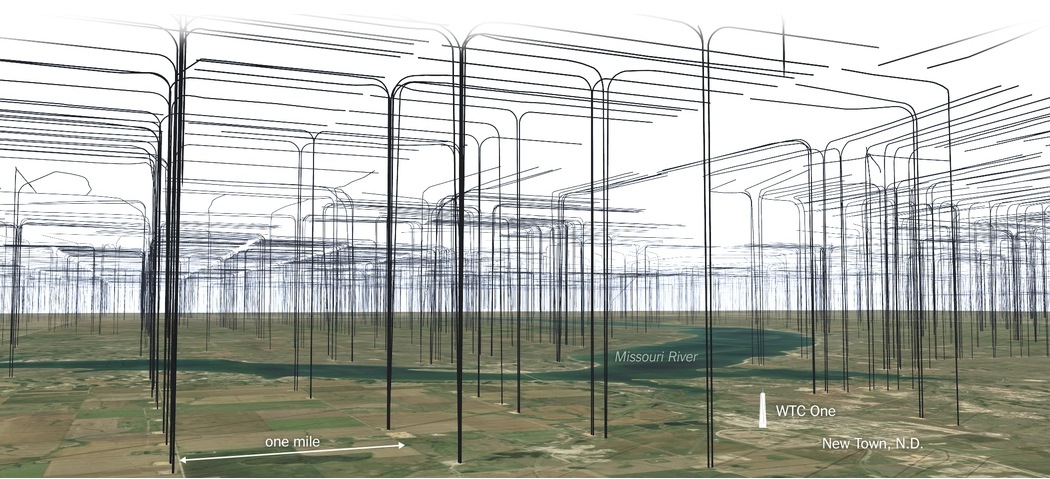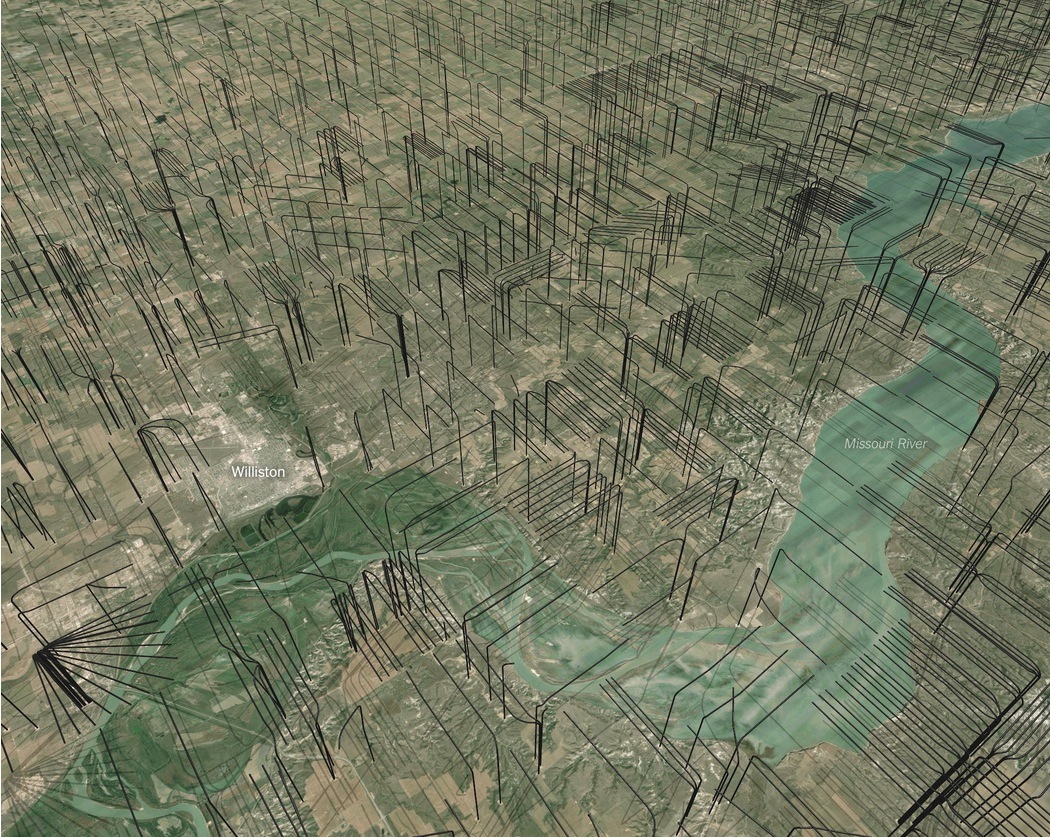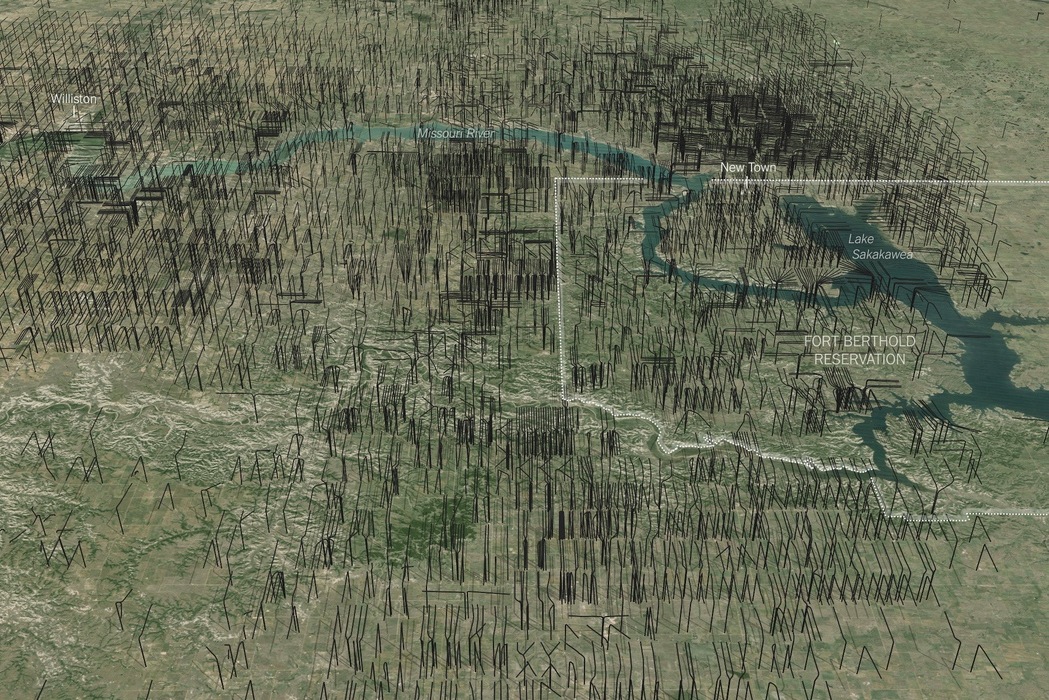Tracking fracking from above with SkyTruth by CBC News, November 27, 2014
The controversial practice of ‘fracking’ has been touted as a boon to some Canadian communities while other parts of the country remain cautious. After residents living close to drilling sites in Pennsylvania began complaining of various health ailments, an organization called SkyTruth used satellite imagery to help researchers scope out the locations of the nearby sites and impoundment ponds. But SkyTruth does more than track fracking. Brent talks to founder and geologist John Amos about the power of SkyTruth’s omniscient environmental eye.
Brent Bambury: Before you started working for Sky Truth you were a geologist. You were working for big oil and gas companies and you decided to walk away. What happened?
John Amos: As part of my job, I was working for consulting firms that did exploration studies for oil and gas and mining companies and we specialized in the use of satellite imagery as a tool for basic geologic mapping around the world, especially looking at remote hard to get to places. On those images, again and again, I would see striking environmental stories. Not necessarily related to oil and gas extraction or mining, but I also did see the serious scars we were leaving on the landscape from human activity, especially from fossil fuel and mineral extraction.
Isn’t there a part of the world that you identified with as a young man where you saw something going on that you didn’t want to happen?
I did my studies as a graduate student in geology at Wyoming. I was doing an exploration study for a company about 10 years later and I noticed the area was just pockmarked with gas drilling sites.
So, fracking?
Yes, the early days of fracking when it was really exploding across public lands in the Rocky Mountain west – Wyoming, Colorado, Utah, Montana – and really happening under the radar of the American public and the environmental community at large. When I saw this radical transformation of what had been a pristine, high plains, ranch land environment into a sprawling industrial facility, I was a little concerned about the scope and rapidity of what was happening on public lands without the public really having any idea.
The idea that this was in a remote place where something could happen without a lot of people noticing, is that part of what Sky Truth looks for when you go out to look for things now?
I like to think that we specialize in making the invisible visible. And that’s whether it’s invisible just because it’s remote and hard to get to or whether it’s invisible because it’s being intentionally hidden from people.
But it’s not always the invisible or intentionally hidden that you’ve gone after because your work was significant in tracking the BP oil spill in the Gulf of Mexico. What did you find out about the BP spill?
As soon as we learned that there had been an explosion and fire on an offshore drilling rig in the Gulf, we were concerned that there might be the potential for a serious spill. We started looking at satellite imagery within the first few days and what we saw was alarming. Within the first week we were able to, just by measuring the size of the oil slick on public, free satellite imagery and making some conservative estimates about the thickness of the oil slick, we were able to conclude that the amount of oil gushing from the well the sea floor was 20 to 25 times greater than what BP was telling the U.S. government and the public at the time. [Encana’s new CEO, Doug Suttles, is being sued for lying about the amount of oil spilled when he was an executive at BP]
In Pennsylvania, people have been living near fracking sites and complaining about headaches, asthma and other symptoms. It’s been difficult for them to get information about those sites, but you’ve been able to find things out. What did you find?
We found hundreds of impoundments scattered throughout the area of drilling. Most of these came into existence during the time period of our study which started with imagery from 2005.
And when you look at that information, what is most striking to you?
The thing that really stands out in general about this modern boom in gas and shale oil drilling is increasingly it’s happening very close to populated places and these facilities are huge. This is not at all like the drilling that happened in the east in Appalachia 50 years ago.
You’re looking for information that is not readily available. Maybe it’s information that some people don’t want to make available. Is it common that you’ll find a difference between what’s reported publicly and what’s really going on?
In general, if there’s any pattern to that, we’ve see that in the size of oil spills that have been reported. There seems to be a very systematic initial under reporting of oil spills by the responsible party. Then, over time, you’ll see revisions to that estimate and the spill steadily inches up, often by several times in terms of the original volume that was reported.
Why do you crowd-source work on the Pennsylvania fracking sites and other projects when you said you could manage it just fine with the team you have?
It’s our hope that by getting hundreds of thousands of people regularly engaged in looking at imagery of environmental issues, we will get some of them to actually care enough that they will get more involved. [Emphasis added]
Interview with John Amos at about 31 Minutes in.
SECRETS SECRETS ARE NO FUN, With eyes in the sky, researchers try to link fracking and illness by Madeleine Thomas, November 12, 2014, Grist
What North Dakota Would Look Like if Its Oil Drilling Lines Were Aboveground by Gregor Aisch, November 25, 2014, The New York Times
More than 11,000 oil wells have been drilled in North Dakota since 2006, covering the state’s agricultural landscape. In all, almost 40,000 miles of well bores have been drilled underground to connect the fracking operations to surface wells. Laid end to end, they would circle the Earth about one and a half times.
On Sunday, The New York Times published a monthslong investigation by Deborah Sontag and Robert Gebeloff into North Dakota’s conflicted relationship with its booming oil industry. In the process of reporting that article, we obtained the locations of every oil drilling line of every well in the state.
The precise depths and directions of these remain out of sight for a very obvious reason: The drilling lines are underground. Here, we change that.
The illustrations shown here are accurate in every respect except one: We changed the vertical direction of each oil well bore to go above ground instead of below it. Otherwise, every bore line is shown precisely how it’s described by North Dakota’s Department of Mineral Resources.
It’s an experiment that may depict the scale of a topic better than reality can. [Emphasis added]
[Refer also to:
Halliburton Pleads Guilty To Destroying Evidence In Connection With Deepwater Horizon Oil Spill
SkyTruth, the environment and the satellite revolution
Meet the Truth about the massive amounts of toxic chemicals used to frac families and their homes




